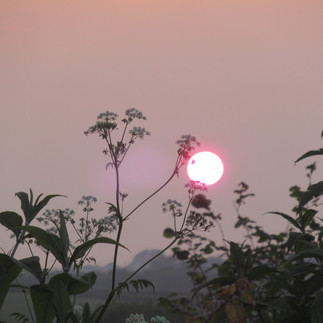May 2024
- Carolyn Thompson

- Jul 22, 2024
- 3 min read
This is the month when we all fall in love with Cornwall again and forgive it for the weeks and weeks of rain soaked dog walks in the howling winds. We still got plenty of that during this May but we also got the lush, verdant, energetic chaos of plants bursting out of the ground and racing for some space in which to grow and thrive. The month sings of life and colour and hope.
The weather continued its pattern of being 'changeable' a description used by the MET and other weather stations, basically telling us that anything could (and did), happen on the weather front. Essentially, burning hot sun when it shone and wild storms when it rained. The vegetable garden was a bit of a disaster as it was too cold to plant out when all the seedlings and young plants were ready to go but the hedges, fields and roadsides all flourished. In our copse we spotted two more self seeded Oaks and a first sighting of a Giant Teasel emerging from the ground but it was down in the field that the real action was taaking place.
Long leggy groups of Cow Parsley lined the hedges and moved out into the field, underneath them blankets of Clover, Speedwells, Plantain, Daisies and Buttercups covered the ground and spilt down the hill. Huge sturdy colonies of Giant Hogweed gave shape and structure to various patches of the field and orchard - these have grown substantially in numbers from last year. I hope that does not continue. They look magnificent but they crowd out other smaller species of wildflowers. Grasses of all shapes and sizes cover the main field; Quaking Grass, Creeping Bent, Creeping Soft Grass, Sheep's Fescue, Yorkshire Fog and many more than I cannot identify. In amongst these grow the different Docks and both the Sheep's and Common Sorrel, and a few groups of Creeping and Marsh Thistles. When we started the re-wilding project the field was completely dominated by these Thistles and the Docks, all of these specis have diminished in their numbers and size.
New colonies of Knapweed have appeared, the Purple Vetch lays itself across the brambles ready to burst into flower later. If a plant isn't already in bloom, it is in a race to find a place to flower freely; both the Cranesbill and Ox Eye Daisies are waiting in the wings to reveal their beauty at some later moment. The main winners of this month for colour and domination of the land has to go to the Pink Campions and the Pink Foxgloves. Together they are a glorious sight to behold. Less showy but still a strong presence is the white blossom of the Hawthorn trees which line the hedges around the fields, releasing a lovely scent when the morning sun warms the flowers.
The Bees that made their home last year in the walls of the cob barn, returned and hovered around the same window but we witnessed no swarms and eventually these visitors left the scene. Many other bees visited and we identified quite a few of them; Red and the White Tailed Bees, Solitary Bees, Common Carder Bees and Honeybees. An assortment of other flying, buzzing, striped characters passed through and yes, I need to work on further identification. What I can say for sure is that there are many more flying insects now than in the first few years of our arrival.
The Swallows are well and truly settled in their old nests and have been giving us daily viewings of their acrobatic feats in the evening. A Robin has also taken up residence in the barn, using the inside of an old cycle helmet for its nest - by the end of the month there were four small faces peering out at us, making their presence known whenever they felt hungry. New life in both field and barn - what more could I ask for?







Comments